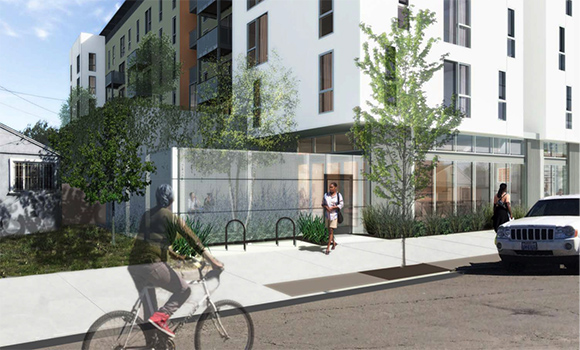
(Photo Credit: Resources for Community Development)
Imagine an apartment building that creates the same amount of energy that it consumes and is close to public transportation, reducing the need for cars. Now, imagine that building houses 59 low-income families who would benefit from the cost savings. That’s the goal of Coliseum Place, an affordable housing complex currently being planned in Oakland.
Projects such as Coliseum Place are much needed in Alameda County because, like the rest of the state, there is a severe shortage of affordable housing. A California Housing Partnership Corporation report issued last year estimates that Alameda County needs 58,680 units to accommodate its low- and very low-income residents.
The Oakland project by Resources for Community Development, a non-profit that provides affordable housing in the Bay Area, will aim to be a net zero energy consumption building. RCD has been accepted to participate in the Living Building Challenge certification pilot program for affordable housing projects. Sponsored by the International Living Future Institute, the challenge encourages developers to meet very high environmental standards including using green materials, installing energy efficient appliances and minimizing water use among others.
Jessica Sheldon, project manager for RCD, explained why achieving the certification is so difficult: “The high bar they’re setting is very, very challenging, especially for affordable housing projects to meet these standards due to cost, as well as regulatory and logistic issues.” Sheldon added, “Our goal is to get to zero net energy, which would mean a very, very tight building envelope, lots of insulation, very efficient heating system and lots of PV [solar shingles] on the roof to offset the energy that we’ll be using.”
Because of its close proximity to a BART station, RCD plans to only have one parking spot for every two units and build more space for bicycles. Working toward net zero energy consumption as well as encouraging residents to use public transportation could also release cap-and-trade dollars to help fund the building’s construction.
“The state is making available some funds in affordable housing and transportation infrastructure improvements through the affordable housing sustainable funding program,” said Sheldon. “So we will apply and hope to get funded through the program next year for Coliseum Place. And we think it’s a great fit because of the transportation location and that’ll really encourage residents to not use cars.”
RCD expects to start construction in 2017, which may coincide with a major redevelopment effort Oakland is planning for that part of the city. The timing is important, given the prospect of increasing gentrification in the city, added Sheldon. Oakland jumped above Washington, D.C. to take the number five spot on a list of median rent for a one-bedroom apartment.
“There’s no requirement right now for any development in the area to be affordable housing,” said Sheldon. “So it could potentially mean a lot of market-rate, high-rent apartments. We think it’s really important to make it now that the area is affordable and get some long-term affordability in there.”
As RCD is demonstrating, it takes planning and foresight to create an affordable housing project that will give low-income residents a home that is environmentally sustainable and restorative in an area that is accessible to their jobs. It is just one step toward the goal the California Economic Summit has set of creating one million affordable housing units in the next decade. This issue will be one of the main topics addressed by business and civic leaders at the California Economic Summit, co-presented by California Forward and the California Stewardship Network, in Ontario on November 12-13.

